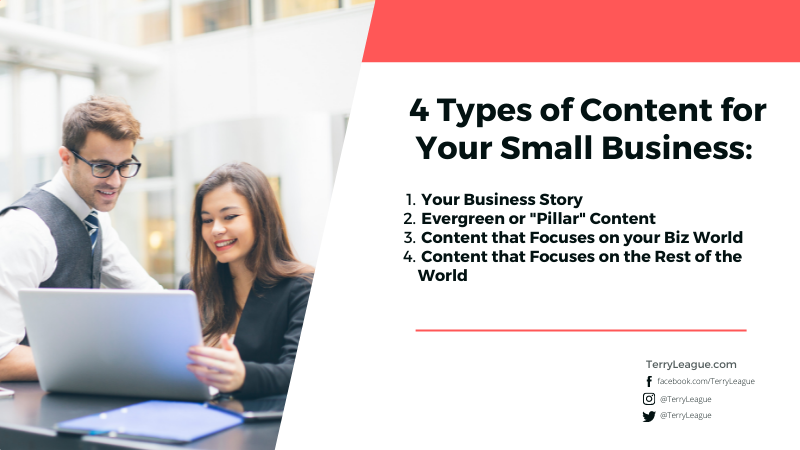
Small business owners are busy people, and trying to consistently post (good) content to your social media sites can be a big challenge!
So let’s spend a few blog posts on some tips for running the content machine necessary to stand out in a noisy online world.
Part 1: What types of content should you create?
Before we get into the specific examples below, let’s define some terms in the context of this post:
Original content: is pretty self-explanatory – you or your team create the content. (Or you outsource it and have someone create original content for you.)
Curated content: is content created by other people: industry influencers, peers, etc. that you share with your audience (sometimes with an opinion on how it can help or affect your community).
When planning content for your social media sites and business blog, here are 4 types to consider:
1. “Who – What – Why” Types of Content
This content explains more about you/your business, the products or services you provide, and why people should buy from you.
It is original content that tells your story, explains how your products/services help your customers, and helps people get to know you.
2. Evergreen or Pillar Content
These 2 buzzwords refer to content that will not expire. Whether educational or informational, this content will apply next week, next month, or next year when it comes to what your business offers customers.
Evergreen means the content lasts forever (or for a very long time). Pillar content may focus on the “pillars” of your business: several topics, purposes, basic products that make up the core of your business.
This is another example of original content.
3. Content that Focuses on Your Business’ World
This content includes Events, Milestones, and News that relates to you or your business. It can include new products/services, new employees, expansion/relocation, new business plans or missions.
This content can be original and curated content: you’ve created it or someone else is writing about you/your business. Also think about using testimonials or photos from customers who are using your products or attending your events.
4. Content that Focuses on the Rest of the World
The “rest of the world” here can be your local area, a more global perspective, or things going on in your industry / related industries.
In summary, it is content that doesn’t necessarily have anything to do with your business/products/services, but it speaks to the lifestyles and topics of interest for your target audience.
Examples include: holiday or community events in your local area, global news or viral content (like the Ice Bucket Challenge), sports teams near you and their current standings. etc.
It may be content that speaks to the human-to-human connection rather than B2C or B2B, topics on other industries that complement/supplement your industry or inspirational posts that connect with your audiences’ emotions.
This content may include original and curated content.
How will you deliver your content?
Now that you know what type of content to create, you should develop a plan to share it with your audience.
It’s best to decide on 1-2 main vehicles to deliver your in-depth or long-form content: a blog, video channel (YouTube), ebook downloads or podcast for example.
Then use your social media sites to share parts or all of that long-form content. In addition, you need to create and share short-form or “snackable” content on social media sites for users’ short attention spans.
Snackable content can include photos on Instagram, short videos on Facebook or Twitter, weekly tips on Facebook, Instagram, Twitter, or a board with top tips on Pinterest, etc.
————-
In part 2, we’ll cover some time-saving tips for creating your content, so you can put a system in place that doesn’t take up your whole day!
You can read Part 2 here: 3 Time-Saving Tips for Creating Content

Need some help putting together a content strategy? Contact me for a free consultation (click here) and let’s discuss some ideas!
[original post updates September 2021]
